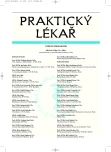-
Medical journals
- Career
Venomous fish – a risk of warm seas
Authors: P. Polák; P. Husa; K. Povolná; R. Svačinka; Z. Svobodová
Authors‘ workplace: Přednosta: prof. MUDr. Petr Husa, CSc. ; Klinika infekčních chorob FN a LF MU Brno
Published in: Prakt. Lék. 2009; 89(12): 685-688
Category: Case Report
Overview
In the era of rapidly developing tourism we have to be prepared for yet unknown or underestimated health-risks resulting from visits to foreign countries. We outline the clinical cases of two patients who were seen at the emergency department of the Department of infectious diseases at the University Hospital in Brno within a very short period of time, both after being stung by venomous fish in the Mediterranean. The species they were stung by were most probably s.c. stonefish (Synanceia) and weeverfish (Trachinus) – both typical benthic fish with well-developed venomous apparatus. The venom of these fish has polymorph effects on the human organism, but only in rare cases is it life-threatening. Nevertheless there may be long lasting consequences. The bacterial infection of the wound may also be a serious complication. First aid consists of applying a warm bath (the venom is termolabile), wound cleaning, potentially using a specific anti-venom. Broad spectrum antibiotic therapy is always indicated. The aim of this article is to highlight some lesser-known risks of visiting of warm seas and to give a complex overview of the medical first aid following such an injury.
Key words:
Synanceia, Trachinus, envenomation, first aid.
Sources
1. Bédry, R., Gromb, S. Les intoxications particulieres de la région aquitaine. La Rev. méd. int. 2009, 30, p. 640-645.
2. Bonnet, M.S. The toxicology of Trachinus vipera: The lesser weeverfish. Brit. Homeopath. J. 2000, 89, p. 84-88.
3. Borondo, J. C., Sanz, P. et al. Fatal weeverfish sting. Hum. Exp. Toxicol. 2001, 20, p. 118-119.
4. Brenneke, F., Hatz, Ch. Stonefish envenomation – A lucky outcome. Trav. Med. Inf. Dis., 2006, 4, p. 281-285.
5. Church, J.E., Hodgson, W.C. Dose-dependent cardiovascular and neuromuscular effects of stonefish (Synanceja trachynis) venom. Toxicon. 2000, 38, p. 391-407.
6. Church, J.E., Hodgson, W.C. The pharmacological activity of fish venoms. Toxicon. 2002, 40, p. 1083-1093.
7. Church, J.E., Hodgson, W.C. Stonefish (Synanceia trachynis) antivenom: in vitro efficacy and clinical use. J. Toxicol. 2003, 22(1), p. 69-76.
8. Currie, B.J. et al. Marine antivenoms. Clin. Toxicol. 2003, 41(3), p. 301-308.
9. Dair, E., Barclay, L. et al. Severe sequelae after stonefish envenomation. Surgeon 2006, 1: p. 384-385.
10. Fenner, P. Marine envenomation: an update – a presentation on the current status of marine envenomation first aid and medical treatments. Emerg. Med. 2000, 12, p. 295-302.
11. Gwee, M. C.E., Gopalakrishnakone, P. et al. A review of stonefish venoms and toxins. Pharm. Ther. 1994, 64, p. 509-528.
12. Khoo, H.E. Bioactive proteins from stonefish venom. Clin. and Exp. Pharmacol. Physiol., 2002, 2, p. 802-806.
13. Khoo, H.E., Yuen, R. et al. Biological activities of Synanceia horrida (Stonefish) venom. Nat. Toxin 1992, 1, p. 54-60.
14. Lyon, R.M. Stonefish poisoning. Wild. Envir. Med. 2004, 15, p. 284-288.
15. Prentice, O., Fernandez, W.G. et al. Case report – stonefish envenomation. Am. J. Emerg. Med. 2008, 26, p. 972.
16. Preuss, J.M. Marine envenomations and toxidromes. Top. Emerg. Med. 2000, 2(2), p. 44-73.
17. Tang, W.M., Fung, K.K. et al. Rapidly progressive necrotising fasciitis following a stonefish sting: a report. J. Orthop. Surg., 2004, 14(1), p. 67-70.
Labels
General practitioner for children and adolescents General practitioner for adults
Article was published inGeneral Practitioner

2009 Issue 12-
All articles in this issue
- Possibilities and necessity of nasal patency evaluation in occupational medicine
- Smoking, tobacco addiction and current treatment options
- Positive thinking, positive motivation, supportive psychotherapy and medical practice
- Venomous fish – a risk of warm seas
- Complicated acute rhinosinusitis – a case report
- Tuberculosis – still a health problem
- New diagnostic approaches to subclinical adrenal insufficiency
- Prognostic factors for the success of extracorporeal shock wave lithotripsy
- Patient satisfaction with health care provided – methods and their use
- General Practitioner
- Journal archive
- Current issue
- Online only
- About the journal
Most read in this issue- Venomous fish – a risk of warm seas
- New diagnostic approaches to subclinical adrenal insufficiency
- Complicated acute rhinosinusitis – a case report
- Possibilities and necessity of nasal patency evaluation in occupational medicine
Login#ADS_BOTTOM_SCRIPTS#Forgotten passwordEnter the email address that you registered with. We will send you instructions on how to set a new password.
- Career

